De—coding Phase 3 of the Planning and Design Code — Paper 4 — Sub—Zones and Heritage
15 December 2020
Continuing in the series, we provide our fourth paper on the Draft Phase 3 Planning and Design Code (“draft Code”) which is subject to public consultation until 18 December 2020.
This paper focuses on the introduction of additional Subzones, contributory items as Representative Buildings and changes to demolition criteria introduced for heritage buildings in the Historic Area Overlay.
Subzones
Subzones are a layer of policy within the Code that sit within Zones, with policy that is intended to reflect local circumstances of specific areas. Subzones are similar to Policy Areas within Zones in Development Plans. Whilst it is counter-intuitive, it is important to note that in the hierarchy of the Code policy, Subzones sit below Overlays but above Zones.
In accordance with the Phase Three (Urban Areas) Planning and Design Code Amendment Summary of Post-Consultation Amendments November 2020 report (“the Report”) the number of Subzones from the original Phase 3 consultation version of the Code (“original Phase 3 Code”) has increased in the draft Code.
On review of the draft Code, the original Phase 3 Code and the current Phase 2 version of the Planning and Design Code (“the Phase 2 Code”) we note that:
- there were 38 Subzones in total in the original Phase 3 Code and the Phase 2 Code;
- seven (7) of the Subzones that were proposed in the original Phase 3 Code have been removed from the draft Code;
- the number of Subzones proposed in the draft Code is 58; and
- there are 27 new Subzones, taking into account those in the original Phase 3 Code and the Phase 2 Code.
The following table provides a comparison of the Zones and Subzones between the draft Code and the original Phase 3 Code and the Phase 2 Code (purple represents the Subzones that have been removed. Green represents new Subzones).
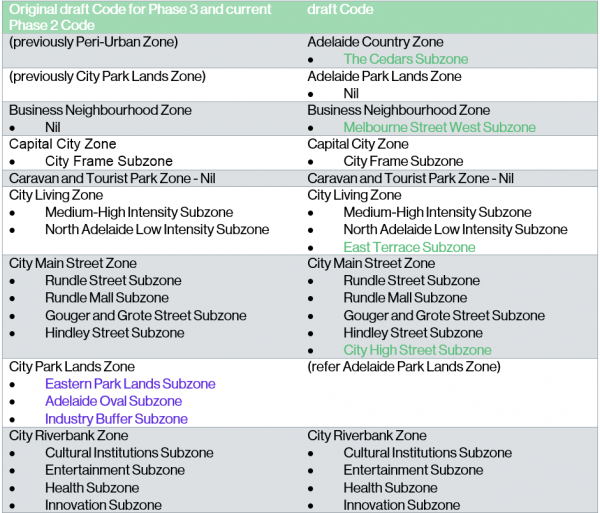
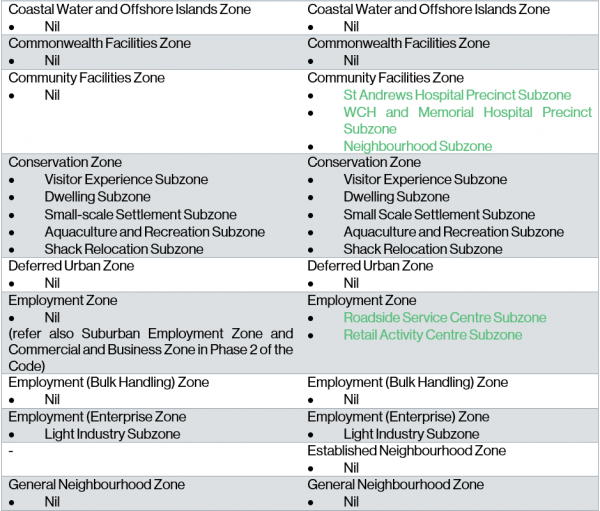
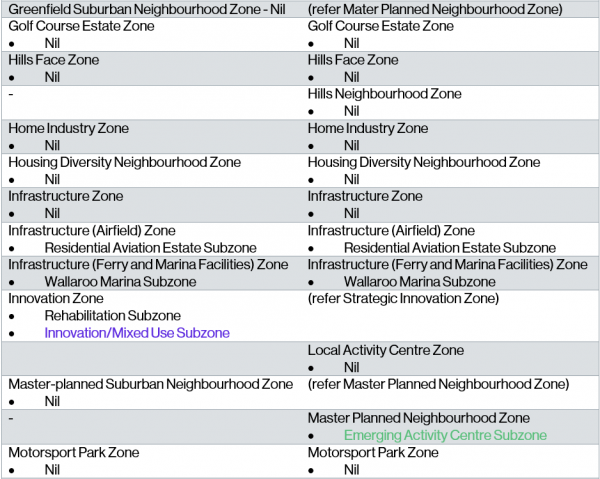
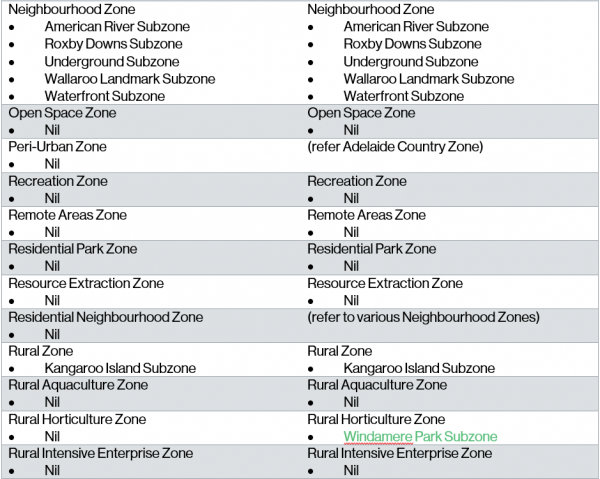



The additional Subzones, coupled with the new Zones, in the draft Code will see a considerable amount of new policy introduced into the Code. We encourage councils to review the Subzones (that are proposed or should apply within the council area) and the mapping to ensure that Subzones apply to the relevant areas and contain appropriate policy for assessment of development.
Councils may also wish to recommend further Subzones for inclusion if areas with specific or unique characteristics are not represented by the existing/proposed Subzones or Overlays.
Representative Buildings, the new contributory items
“Representative Building” is a new term introduced into the draft Code to identify those buildings that were previously recognised as contributory items in council Development Plans. This is a significant and welcome inclusion in the draft Code as there had, previously, been strong opposition to the inclusion of contributory items in the Code.
Representative Buildings are defined in the draft Code as follows:
Representative buildings referenced in Historic Area Statements and Character Area Statements and mapped in the South Australian Planning and Property Atlas are buildings which display characteristics of importance in a particular area. The identification of representative buildings in a particular area is not intended to imply that other buildings in an historic area are not of importance.
The Character Area and Historic Area Statements in the draft Code list Representative Buildings as being either “not identified” or as “Identified – refer to SA Planning database”. There is no specific identification (i.e. address) of Representative Buildings in the Statements or elsewhere in the draft Code. Representative Building are only identified on the South Australia Property and Planning Atlas (“SAPPA”).
The rules of interpretation for the Code means that it will operate in conjunction with SAPPA and other related databases. The purpose of this is to enable spatial and textual data to be brought together in the SA Planning data base on Plan SA.
What this means is that Representative Buildings will be captured in the Code as Representative Buildings, but only if they are identified as such on SAPPA.
You can search the Representative Buildings on SAPPA (training version) as follows:
Step 1: Click on “Layers” and open the drop-down menu for “Planning and Building”
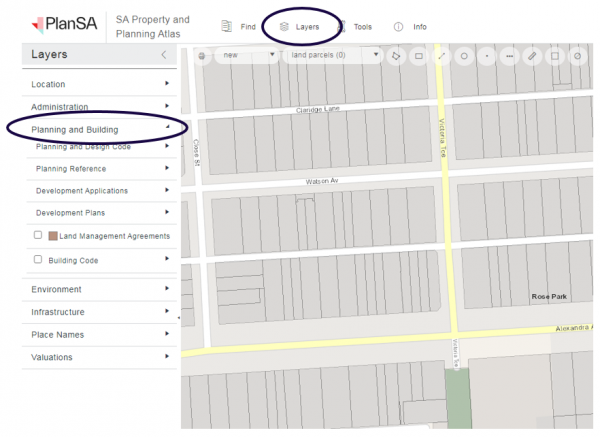
Step 2: Open drop-down menu “Planning Reference”
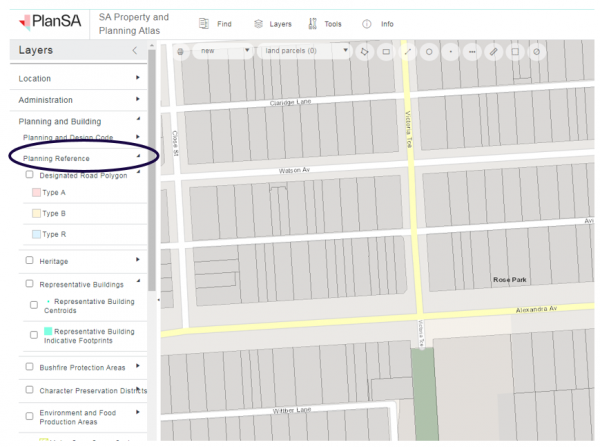
Step 3: Open the drop-down menu in “Heritage” and click the box for either “Representative Building Centroids” or “Representative Building Indicative Footprints”
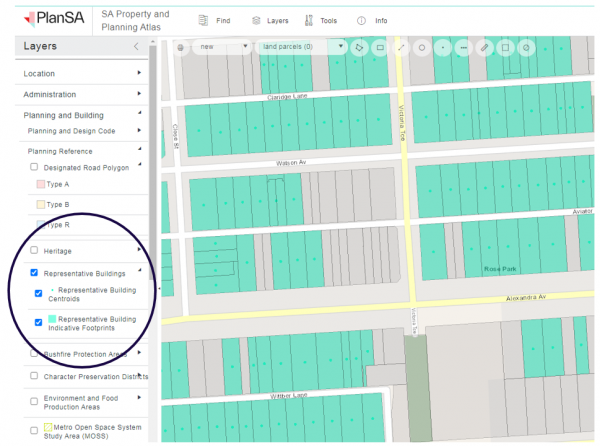
Specific identification of Representative Buildings within the draft Code is preferable, whether in the Character Area or Historic Area Statements or through a separate table for ease of reference. Alternatively, it would be useful if the draft Code provided a hyperlink to the SAPPA GIS overlay with specific reference to Representative Buildings. Without this it is arduous to identify Representative Buildings that will be included in the draft Code.
Where current contributory items are not located within the Character Area or Historic Area Overlays, these buildings will not be it captured in the draft Code as Representative Buildings. To capture additional Representative Buildings adjustment to the boundaries of the Historic Area and Character Area Overlay is proposed. However, it is not clear where the newly adjusted boundaries will apply.
We encourage councils to review the Character Area and Historic Area Overlays and Statements and provide feedback on Representative Buildings that should be included in the Statements and identify locations where the Overlays should apply.
Heritage and Character – Additional protections
In response to submissions received during the first round of public consultation and concerns raised in respect of protection of heritage and character the following is now proposed as part of the draft Code amendments:
- Historic Area Statements are to be strengthened to better reference the valued attributes of a particular area, adding additional design detail together with limited historical background in some Statements to clearly articulate the historical importance of the area. Councils should carefully review the Historic Area Statements that apply in their area to ensure they reflect the specific heritage attributes of the area.
- New development in the Historic Area and Character Area Overlays will be supported by a design guideline that sits beside the Code. The design guideline has not been prepared so its contents is unknown. However, it is intended to include diagrams and style guides.
- The demolition tests within the Historic Area Overlay (PO 7.1) has been amended to replace the ‘economic test’ with one of ‘reasonableness’. The wording for the demolition test will now read:

- The concept of “reasonable repair” will include reference to economic considerations but is broader and arguably could include ongoing use and other practical considerations.
- More information regarding this is available in the SCAP’s “Preserving Heritage and Character in the Planning and Design Code”.
- All State Heritage Places, State Heritage Areas, Local Heritage Places and Historic Areas, including those that contain Representative Buildings will include demolition controls. Although we note that the same demolition controls are not provided in the Character Area Overlay and as such Representative Buildings in the Character Area (and not within the Historic Area Overlay) will not be afforded the same level of protection.
- To ensure local context and historic values are considered as part of a development application, links have been established between the State Heritage Area Overlay and the ‘State Heritage Areas – Guidelines for Development’ prepared by Heritage SA. The Attorney-General’s Department has confirmed that this is provided for through DO1 in the State Heritage Area Overlay that states:
- DO1 Development maintains the heritage and cultural values of State Heritage Areas through conservation, ongoing use and adaptive reuse consistent with Statements of Significance and other relevant documents prepared and published by the administrative unit of the Public Service that is responsible for assisting a Minister in the administration of the Heritage Places Act 1993.
For further information regarding the draft Code, please contact:
Victoria Shute: vshute@kelledyjones.com.au
David Altmann: answers@developmentanswers.com.au

LINKS TO PAST PAPERS:

